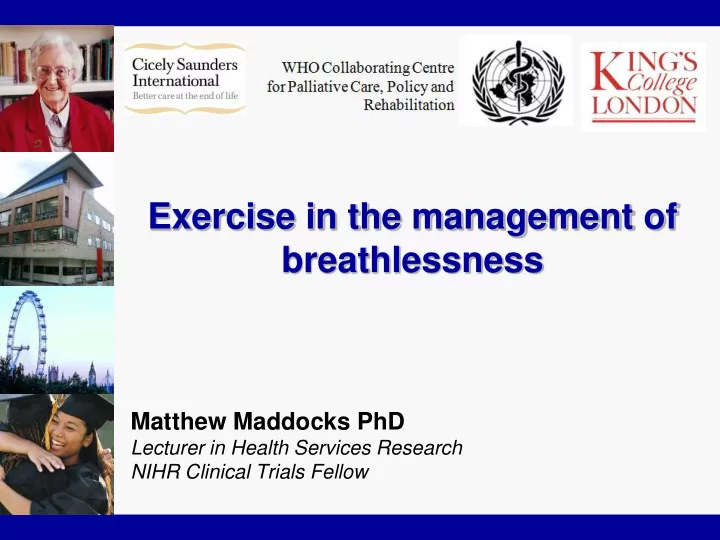

WHO Collaborating Centre for Palliative Care and Older People Exercise in the management of breathlessness Matthew Maddocks PhD Lecturer in Health Services Research NIHR Clinical Trials Fellow
Background • Breathlessness is common in advanced disease – 90% chronic lung disease – >50% cancer or heart failure – renal / liver failure, neurological conditions, HIV/AIDS. • It causes considerable distress and disability. • It results in unplanned hospital attendances. • Many perceive it as a challenge to treat (confidence, structured approach, knowledge of treatments etc). Maddocks et al. J Palliat Med 2015.
Breathlessness is (a bit) like pain… Domain Description Sensory-perceptive what does your breathing feel like and how bad is it? Affective distress how distressing or unpleasant is your breathing? Symptom impact or burden how does your breathing affect your function? Parshall et al. AJRCCM 2012;185:435-52.
The deconditioning spiral • Treatment goal: break or slow down the spiral • Requires education / reassurance around normal exertional response and recovery Maddocks & Wilcock. Lung Cancer 2012;76:128-9. Donaldson et al. Int J COPD 2012;7:523-535.
Detrimental effect of bed rest on muscle Changes are about 10-fold compared to the typical response in a young adult Kortbein JAMA 2007
Jolley & Moxham Eur Resp Rev 2009;818:66-79.
Pulmonary rehabilitation
Jolley & Moxham Eur Resp Rev 2009;818:66-79.
Current evidence for PR • Overwhelming evidence supports exercise in the context of pulmonary rehabilitation (PR) • CRQ dyspnoea scale – ↑ 0.79 (CI 0.56−1.03), n=1283 • SGRQ total score – ↓ 6.89 (CI 9.26−4.52), n=1146 • Exercise performance – shuttle walk ↑ 39.8 m (CI 22.4−57.2), n=694 – 6 min walk ↑ 44.0 m (CI 32.6−55.2), n=1879 McCarthy et al. Cochrane Database Syst Rev. 2015;2:CD003793.
CRQ dyspnoea domain (n=1286)
CRQ Mastery (n=1212)
PR and breathlessness • Rehabilitation compared to usual care (n=41) Domain Assessments Sensory-perceptive Exertional breathlessness intensity ratings and quality descriptors Affective distress Intensity of breathing-related anxiety during exercise; COPD / walking self-efficacy Symptom impact or MRC dyspnoea scale; Transition Dyspnoea burden Index; CRQ dyspnoea scale; SRGQ activity scale; walking / cycling exercise performance Wadell et al. COPD 2013;10:425-35
PR and breathlessness Wadell et al. COPD 2013;10:425-35
Upper limb exercise
Jolley & Moxham Eur Resp Rev 2009;818:66-79.
Upper limb exercise • Exercise training in COPD often focuses on lower limb training (walking, cycling) • 24 studies (n= ) • Improvements in: – Endurance capacity (SMD=1.25; 0.16 to 2.66) – Peak exercise capacity (SMD=1.27; 0.59 to 1.94) – Arm muscle strength (SMD=0.46; 0.10 to 0.81) Kathiresan et al. J Thorac Dis 2010;2:223-36.
Arm exercise - breathlessness (intensity) During exercise WMD −0.34 (95% CI −0.78 to 0.09) During daily activity WMD − 0.58 (95% CI −1.13 to −0.02)
Arm exercise – arm fatigue (intensity) During exercise WMD 0.24 (95% CI −0.33 to 0.81) During daily activity WMD −0.55 (95% CI − 1.08 to − 0.01)
Neuromuscular electrical stimulation
Jolley & Moxham Eur Resp Rev 2009;818:66-79.
NMES in advanced disease: exercise VO 2 max during CPET improved in 2 of 3 studies. Maddocks et al. Cochrane Database of Systematic Reviews 2013;1:CD009419
NMES and breathlessness • Reduced functional impact of breathlessness – CRQ dyspnoea – Maugeri Resp Failure dyspnea in daily tasks • Reduced breathlessness at exercise isotime – demonstrated in 2 of 3 studies – corresponding increases in exercise endurance – single case of increased inspiratory capacity Maddocks et al. Cochrane Database of Systematic Reviews 2013;1:CD009419
Take home messages • A strong rationale and evidence base supports a role for exercise in breathlessness management • Exercise is an exemplar for treating ‘total’ breathlessness - not just symptom intensity
Thank you matthew.maddocks@kcl.ac.uk @CSI_KCL
Recommend
More recommend